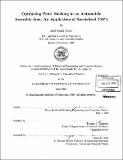| dc.contributor.advisor | Thomas L. Magnanti. | en_US |
| dc.contributor.author | Sokol, Joel Scott, 1971- | en_US |
| dc.contributor.other | Massachusetts Institute of Technology. Dept. of Electrical Engineering and Computer Science. | en_US |
| dc.date.accessioned | 2010-09-13T14:04:31Z | |
| dc.date.available | 2010-09-13T14:04:31Z | |
| dc.date.copyright | 1999 | en_US |
| dc.date.issued | 1999 | en_US |
| dc.identifier.uri | http://hdl.handle.net/1721.1/58514 | |
| dc.description | Thesis (Ph. D.)--Massachusetts Institute of Technology, Sloan School of Management, Operations Research Center, 1999. | en_US |
| dc.description | Submitted to the Dept. of Electrical Engineering and Computer Science, MIT. | en_US |
| dc.description | Includes bibliographical references (p. 110-114). | en_US |
| dc.description.abstract | In the automobile manufacturing industry, vehicle production is an assembly-line process. Automobile companies typically sequence vehicle production based on workload balancing factors, with little consideration of vehicle colors. The resulting sequence usually has a small average paint block size. Because automobile manufacturers use expensive and sometimes pollutant chemicals to clean out old paint at each color change, they would like to increase the size of the paint blocks, while maintaining the original workload-balanced vehicle sequence. To achieve this goal, Ford and other automobile manufacturers are considering automated vehicle storage and retrieval systems that would allow them to perturb the original sequence around the vehicle painting station, creating larger paint blocks and then restoring the original sequence after painting. To evaluate these systems, it is necessary to develop a method for re sequencing cars and for calculating the resulting savings in paint cleanings. The problem of resequencing can be cast as a traveling salesman problem with time windows. For a real-life sequence size of 750 cars and windows of 75 slots per car in either direction, direct modeling using the strongest known ... formulation yields an integer program with up to 200,000 constraints and 14,000,000 variables. Reduced formulations. We exploit special problem structure to solve the LP relaxation of this problem quickly using Lagrangean relaxation. We prove and use an order-within-color property to construct an enumerative formulation, and use a greedy approach to bound the LP optimum. We decompose the problem and solve smaller enumerative formulations sequentially to generate a heuristic solution that empirically is within 2.5% of optimality. Because our heuristic and bounding procedure runs in a total of one minute, an automobile manufacturer could use the process to adjust the resequencing process in real time to compensate for vehicles that have been delayed in the original sequence due to production defects or other disruptions. We also establish worst-case bounds ranging from 2.5 to 6 for another related heuristic. | eb_US |
| dc.description.statementofresponsibility | by Joel Scott Sokol. | en_US |
| dc.format.extent | 114 p. | en_US |
| dc.language.iso | eng | en_US |
| dc.publisher | Massachusetts Institute of Technology | en_US |
| dc.rights | M.I.T. theses are protected by
copyright. They may be viewed from this source for any purpose, but
reproduction or distribution in any format is prohibited without written
permission. See provided URL for inquiries about permission. | en_US |
| dc.rights.uri | http://dspace.mit.edu/handle/1721.1/7582 | en_US |
| dc.subject | Operations Research Center. | en_US |
| dc.subject | Electrical Engineering and Computer Science. | en_US |
| dc.title | Optimizing paint blocking in an automobile assembly line : an application of specialized TSP's | en_US |
| dc.type | Thesis | en_US |
| dc.description.degree | Ph.D. | en_US |
| dc.contributor.department | Massachusetts Institute of Technology. Operations Research Center | en_US |
| dc.contributor.department | Massachusetts Institute of Technology. Department of Electrical Engineering and Computer Science | en_US |
| dc.contributor.department | Sloan School of Management | |
| dc.identifier.oclc | 42919870 | en_US |
